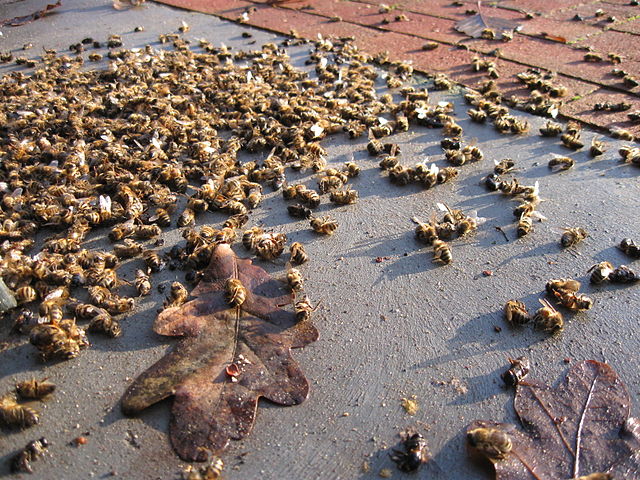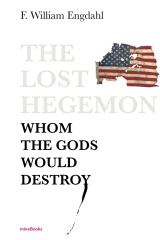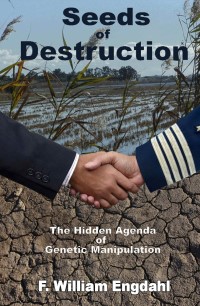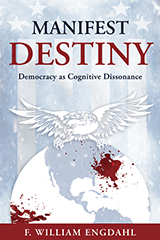
German Government Uses Lockdown to Sneak Deadly Pesticide
By F. William Engdahl
4 January 2021
Image: Dead honeybees in front of a beehive. Dode honingbijen voor een bijenkast. Author: Skinkie License: This file is made available under the Creative Commons CC0 1.0 Universal Public Domain Dedication. License Source: https://commons.wikimedia.org/wiki/File:Deadhoneybees.jpg
Using the conditions of the most recent coronavirus lockdown, the German government’s agriculture minister has made a stealth decision, without open debate, to re-instate a banned class of systemic insecticides known as neonicotinoids. The German move follows a similar move by the French Macron government and puts the entire food security of the EU in serious danger. Ironically, or maybe not, the move comes at a time when food security worldwide is in grave stress owing to consequences of the global COVID lockdowns that have disrupted huge parts of the global food chains.
On December 15, Julia Klöckner (CDU), the German minister responsible for agriculture, approved “emergency” certification of “limited” use of the highly controversial insect killing chemicals known as neonicotinoids. While the order is disguised as a limited emergency exception to a current EU-wide ban on the chemicals, environmental organizations argue that it is just the beginning of a stealth re-approval of the chemicals that have been banned since 2013.
Bee colony collapse
In 2012 several scientific studies showed that the use of neonics as they are called, spread into agricultural irrigation channels and soil where they remained. The studies also linked the chemicals to a dramatic rise in bee colony deaths across the EU. In 2013 the EU official agency, the European Food Safety Authority (EFSA), after a formal review declared that neonicotinoids pose an unacceptably high risk to bees, and that the industry-sponsored studies from Bayer, Syngenta and other agrochemical firms upon which regulatory agencies’ claims of safety have relied on were flawed. That resulted in the first EU-wide ban of the chemicals.
In 2018 the EFSA, reacting to growing pressure from the agrochemical industry to lift the ban, issued a new report that said the neonics posed a serious danger not only to honey bees but also to wild bees. Other studies have shown that a single seed treated with neonics is enough to kill a songbird Neonicotinoids have the potential to affect entire food chains. They are persistent in the environment, infiltrate groundwater, and have cumulative and largely irreversible effects on invertebrates.
In 2018 a new EU-wide ban on all outdoor use of the insecticides was imposed. This is what the German government, following France, is now subverting with the ruse of “emergency limited use.”
At stake is far more than the future of bees. As the chemicals come into widespread use on numerous crops, evidence indicates that they kill more than bees. In fact they seem to kill all pollinating insects and many species of bird that feed off insects. This is not minor.
Pollinators
Few of us in today’s urban societies may be aware of the vital role in our food chains of bees and other pollinating insects.
The honey bee, Apis mellifera, is the most important pollinator of agricultural crops. Honey bees pollinate over 70 out of 100 crops that in turn provide 90% of the world’s food. They pollinate most fruits and vegetables–including apples, oranges, strawberries, onions and carrots.
But while managed honey bee populations have increased over the last 50 years, bee colony populations have decreased significantly in many European and North American nations. Simultaneously, crops that are dependent on insects for pollination have increased. The phenomenon of bee deaths is known by the deceptive term, Colony Collapse Disorder (CCD), implying it could be caused by any number of factors. Serious recent scientific studies however point to a major cause: use of new highly toxic systemic pesticides, neonics, widely used in agriculture since about 2004.
Already in January of 2012, the US Department of Agriculture published a report from scientists under the direction of Jeffrey Pettis of the USDA Bee Research Laboratory. The study, published in the German scientific journal, Naturwissenschaften, concluded that there was “an interaction between sub-lethal exposure to imidacloprid (Bayer’s Gaucho—w.e.) at the colony level and the spore production in individual bees of honey bee gut parasite Nosema.” Moreover, the study went on, “Our results suggest that the current methods used to evaluate the potential negative effect of pesticides are inadequate…we believe that subtle interactions between pesticides and pathogens, such as demonstrated here, could be a major contributor to increased mortality of honey bee colonies worldwide.”
Renowned Dutch toxicologist, the late Dr. Henk Tennekes reported that same year 2012 that, unlike claims from Bayer and other neonicotinoid manufacturers, bees living near maize fields sprayed with the toxic pesticides are exposed to the neonicotinoids throughout the entire growing season, and the toxin is cumulative, just as is glyphosate in Bayer’s Roundup. Tennekes noted, “Bees are exposed to these compounds and several other agricultural pesticides, in several ways throughout the foraging period. During spring, extremely high levels of clothianidin and thiamethoxam were found in planter exhaust material produced during the planting of treated maize seed. We also found neonicotinoids in the soil of each field we sampled, including unplanted fields.” (emphasis added)
Effect on Human Brain?
Most alarming of all is the evidence that exposure to neonicotinoids has possible effects on humans as well as on birds and bees. Professor Tennekes described the effects: “Today the major illnesses confronting children in the United States include a number of psychosocial and behavioral conditions. Neurodevelopmental disorders, including learning disabilities, dyslexia, mental retardation, attention deficit disorder, and autism – occurrence is more prevalent than previously thought, affecting 5 percent to 10 percent of the 4 million children born in the United States annually… Prenatal and childhood exposures to pesticides have emerged as a significant risk factor explaining impacts on brain structure and health that can increase the risk of neurological disease later in life.”
There is also growing evidence suggesting persistent exposure to plants sprayed with neonicotinoids could be responsible for damage to the human brain, including the recent sharp rise in incidents of autism in children.
Referring to recent studies of the effects of various exposures of neonicotinoids to rats, Tennekes noted, “Accumulating evidence suggests that chronic exposure to nicotine causes many adverse effects on the normal development of a child. Prenatal exposure to nicotine is a known risk factor for sudden infant death syndrome, low-birth-weight infants, and attention deficit/hyperactivity disorder. Therefore, the neonicotinoids may adversely affect human health, especially the developing brain.”
Tennekes was rewarded for his groundbreaking exposure of the dangers from Bayer, Syngenta, BASF and other chemical makers of neonicotinoids, including evidence that Bayer had researched the deadly effects of neonicotinoid on flies as early as 1991, by being blacklisted as a toxicology consultant and losing all his clients. Despite that, he continued to publicize the dangers of neonics, a danger that was finally recognized by the EU ban in 2013 and is now being ignored to the detriment of not only bees or birds but also of human health.
F. William Engdahl is strategic risk consultant and lecturer, he holds a degree in politics from Princeton University and is a best-selling author on oil and geopolitics, exclusively for the online magazine “New Eastern Outlook”




